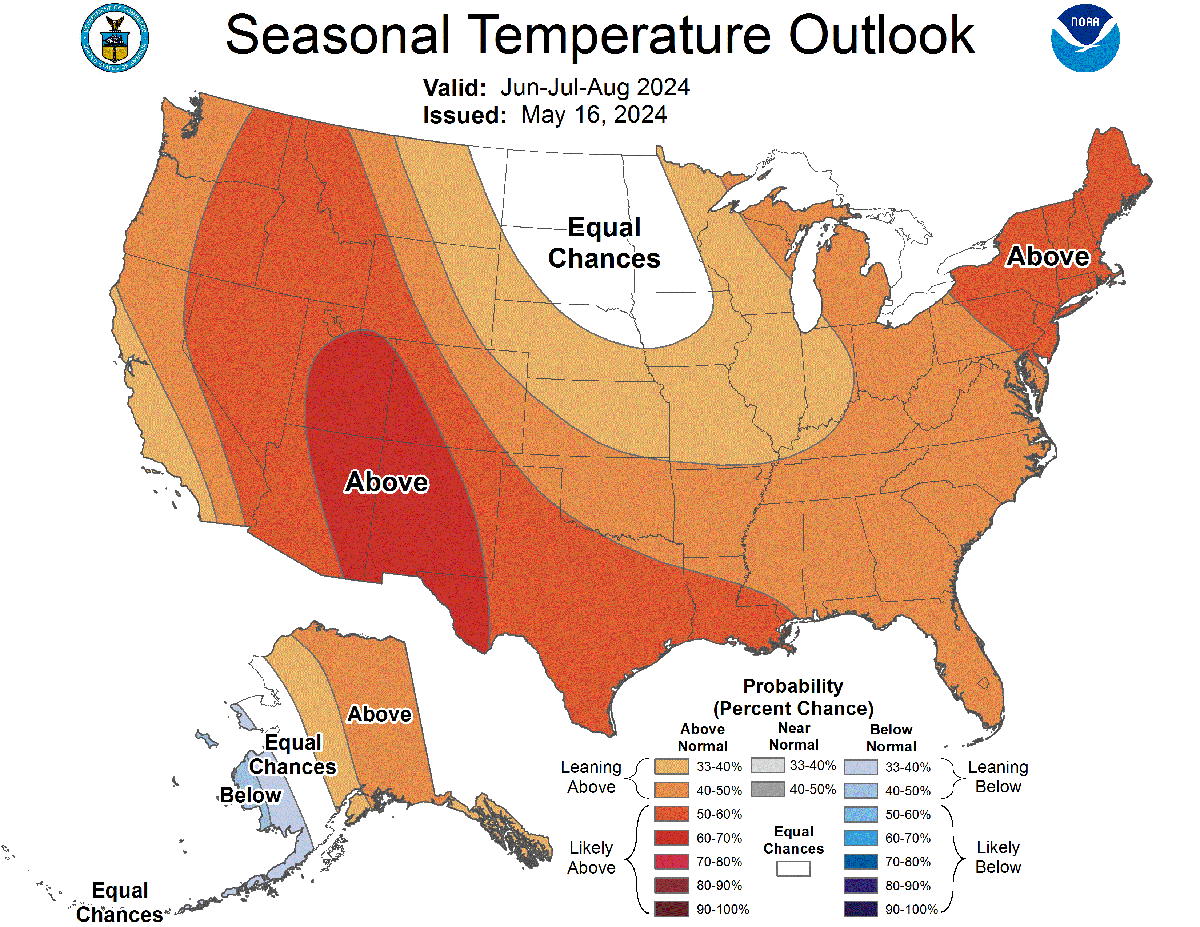
A study on last year’s extreme heat and the National Weather Service’s most recent seasonal outlook both point to 2024 being just as warm or even warmer than 2023’s record-breaking temperatures.
Researchers behind the study, “2023 summer warmth unparalleled over the past 2,000 years,” found that not only was 2023 reported as the hottest year on record, for most of the Northern Hemisphere, the year also included the warmest summer in 2,000 years.
Supporter Spotlight
Dr. Jan Esper and Dr. Max Torbenson, geography professors at Johannes Gutenberg University in Germany, and Dr. Ulf Büntgen, a professor from Cambridge’s Department of Geography, wrote the study published this month in the journal Nature.
Esper explained during a recent online press briefing that the study places the 2023 temperature extremes into a long-term context, in this case the last two millennia.

They combined existing meteorological records with data from the nine longest temperature sensitive tree-ring chronologies to examine June, July and August surface air temperatures in the Northern Hemisphere extra-tropics, Esper said. This region is between the latitude line that runs through New Orleans and Cairo, or 30 degrees north, and the North Pole, 90 degrees north.
The researchers also found that the temperature baseline from the 19th century used to contextualize global warming for the Paris Agreement is cooler by a few tenths of a degree than previously thought.
This period is really not well covered with instruments, Esper said of the years 1850-1900, but at least for the region in the Northern Hemisphere that was studied, the tree rings “can do really, really well.” He said the tree ring data can be used as a substitute and show the early instrumental temperature errors.
Supporter Spotlight
The study also found that in the last 60 years, greenhouse gas emissions have caused El Niño events to become stronger, leading to hotter summers, and 2023 is consistent with a greenhouse gases-induced warming trend that is amplified by an unfolding El Niño event.
The current El Niño is forecast to end early this summer, and past data shows that there is a lag between extreme El Niño conditions and large-scale temperature deviations, making it likely that 2024 will see temperature records broken again.
“When you look at the long sweep of history, you can see just how dramatic recent global warming is,” Büntgen said in a statement. “2023 was an exceptionally hot year, and this trend will continue unless we reduce greenhouse gas emissions dramatically.”
Officials with the National Oceanic and Atmospheric Administration’s National Centers for Environmental Information explained in its global monthly report that April 2024 is the 11th-consecutive month of record-high global temperatures. The month ranked as the warmest April on record, suggesting that Büntgen is right that the heat trend is continuing.
According to the global annual temperature rankings outlook, “there is a 61% chance that 2024 will rank as the warmest year on record and a 100% chance that it will rank in the top five of warmest years recorded.”
And, “based on current anomalies and historical global annual temperature readings, it appears that it is virtually certain that 2024 will be a top 10 year, consistent with a strong propensity since 1988 for recent years to be initially ranked as a top 10 year,” NOAA officials said.
State relief programs
To help communities take action to reduce the health effects caused by extreme heat exposure, Gov. Roy Cooper’s office announced Tuesday that May 26-June 1 is North Carolina Heat Awareness Week, and reminded residents of the state’s heat-preparedness tools.
“As our summers continue to get hotter, today’s proclamation raises awareness of the many tools and resources available to keep our communities safe from extreme heat,” Cooper said.
On the state level, several programs have been launched to help communities weather the heat, especially for outdoor workers, infants and children, older adults, pregnant people, athletes, low-income individuals and people with underlying health conditions who are at higher risk for heat-related illnesses.
The N.C. Office of Recovery and Resiliency, N.C. Department of Health and Human Services, N.C. State Climate Office and the Duke University Heat Policy Innovation Hub teamed up to create the Heat Action Plan Toolkit for health departments, local governments and other community partners to develop their own plans specific to their needs.
Chief Resilience Officer Dr. Amanda Martin told Coastal Review Wednesday that the state wants everyone to know the signs of heat illness when they are enjoying the summer sun at the coast.
“Extended extreme heat is dangerous to the human body. Perhaps just as dangerous as the actual heat is ignoring the protective factors that reduce and eliminate heat illness and death,” Martin said. “Last year was the hottest year in 2,000 years, so it’s more important than ever for outdoor workers and indoor workers without air conditioning to take breaks, access cooler air, and drink water. Senior citizens, young children and people with health conditions are especially vulnerable to heat waves.”
Also, the state Health and Human Services’ Climate and Health Program launched its Heat Health Alert System this month to notify subscribers when the heat index is expected to reach unhealthy levels in their county. The program operates a Heat-Related Illness Surveillance System from May through September and documents weekly emergency department visits for heat-related illness in the state.
“We want all North Carolinians to enjoy a safe and healthy summer,” said Dr. Susan Kansagra, Health and Human Services Assistant Secretary for Public Health, in a news release. “With more than 3,900 emergency department visits for heat-related illness in North Carolina last summer, preparing for extreme heat at the local level is critical to protecting the health of North Carolina residents and workers.”
The Office of Recovery and Resiliency announced last week its newest product, the NC Resilience Exchange website, an interactive resource to help local and state leaders find relevant information in the wealth of climate data available online.
“The Exchange offers funding opportunities, a directory of experts, interactive mapping tools, model ordinances and more in a one-stop-shop that is relevant to North Carolina communities,” according to the website.
Federal efforts
At the federal level, the Biden-Harris administration on May 20 announced it had committed $4.55 million for the interagency National Integrated Heat Health Information System “to enhance community science observations and data collection on extreme heat, and provide assistance to communities planning for and evaluating equitable heat resilience projects.”
NOAA and the Centers for Disease Control and Prevention founded the system in 2015 to lead developing community resilience to the effects of extreme heat.
The Center for Collaborative Heat Monitoring based at the Museum of Life and Science in Durham will assist organizations conduct local climate and health studies. The Center for Heat Resilient Communities that will be based out of California and Arizona is to offer diverse expertise and knowledge-sharing hubs to identify and evaluate policies, protocols, and lessons for heat resilience.
“The impacts of extreme heat caused by climate change are an increasing threat to our health, ecosystems and economy,” U.S. Secretary of Commerce Gina Raimondo said in a statement, adding that this investment will support new Centers of Excellence “to help protect historically excluded communities from the dangers of extreme heat, boost climate resilience and increase awareness on best practices to tackle the climate crisis.”
The Durham center will work with the Arizona Science Center, the Oregon Museum of Science and Industry, and the Museum of Science in Boston to serve the entire country at a regional level.
Officials with the museum said the center will observe, monitor and evaluate factors influencing heat risk at a local scale in 30 historically disadvantaged communities over the next three years. The center is a broad collaborative effort leveraging these place-based institutions and supported by the technical capacity and expertise at CAPA Strategies, Utah State University, the North Carolina State Climate Office, and AQUEHS Corp.
“The past few years have shown us that we can work towards fixing what we can measure,” said Max Cawley, principal investigator for new center and the Museum of Life and Science’s Director for Climate Research and Engagement. “And when it comes to heat imperilment, how you measure also matters. We’re eager to convene a strong collaborative partnership towards expanding where we can measure heat and who’s involved in measuring it.”
Last month, the National Weather Service and the CDC released an experimental online tool called HeatRisk.
HeatRisk provides a color-coded forecast of risk of heat-related impacts that could occur over a 24-hour period. HeatRisk takes into consideration how unusual the heat is for the time of the year, the duration of the heat including both daytime and nighttime temperatures, and if those temperatures pose an elevated risk of heat-related impacts based on data from the CDC, according to the website.
“Climate change is causing more frequent and intense heat waves that are longer in duration, resulting in nearly 1,220 deaths each year in the U.S. alone,” NOAA Administrator Dr. Rick Spinrad said in April when the tool was released. “Last year was the warmest year on record for the globe, and we just experienced the warmest winter on record. HeatRisk is arriving just in time to help everyone, including heat-sensitive populations, prepare and plan for the dangers of extreme heat.”
CDC Director Mandy Cohen explained during a news conference that the tool will help “protect health and improve lives and to prepare for what we anticipate will be a very hot summer. Heat is a threat to our health. Heat can make underlying health conditions worse and heat related illness like heat exhaustion and heat stroke can cause serious illness and even lead to death. Heat can be especially dangerous for certain people, including very young kids.”







